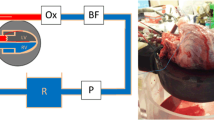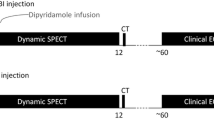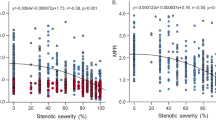Abstract
Objective
To validate fast perfusion mapping techniques in a setting of coronary artery stenosis, and to further assess the relationship of absolute myocardial blood volume (MBV) and blood flow (MBF) to global myocardial oxygen demand.
Methods
A group of 27 mongrel dogs were divided into 10 controls and 17 with acute coronary stenosis. On 1.5-T MRI, first-pass perfusion imaging with a bolus injection of a blood-pool contrast agent was performed to determine myocardial perfusion both at rest and during either dipyridamole-induced vasodilation or dobutamine-induced stress. Regional values of MBF and MBV were quantified by using a fast mapping technique. Color microspheres and 99mTc-labeled red blood cells were injected to obtain respective gold standards.
Results
Microsphere-measured MBF and 99mTc-measured MBV reference values correlated well with the MR results. Given the same changes in MBF, changes in MBV are twofold greater with dobutamine than with dipyridamole. Under dobutamine stress, MBV shows better association with total myocardial oxygen demand than MBF. Coronary stenosis progressively reduced this association in the presence of increased stenosis severity.
Conclusions
MR first-pass perfusion can rapidly estimate regional MBF and MBV. Absolute quantification of MBV may add additional information on stenosis severity and myocardial viability compared with standard qualitative clinical evaluations of myocardial perfusion.






Similar content being viewed by others
References
Maher VM (1995) Coronary atherosclerosis stabilization: an achievable goal. Atherosclerosis 118(Suppl):S91–S101
Schwitter J, Nanz D, Kneifel S (2001) Assessment of myocardial perfusion in coronary artery disease by magnetic resonance: a comparison with positron emission tomography and coronary angiography. Circulation 103:2230–2235
Picano E, Molinaro S, Pasanisi E (2008) The diagnostic accuracy of pharmacological stress echocardiography for the assessment of coronary artery disease: a meta-analysis. Cardiovasc Ultrasound 6:30
Le DE, Bin JP, Coggins MP et al (2002) Relation between myocardial oxygen consumption and myocardial blood volume: a study using myocardial contrast echocardiography. J Am Soc Echocardiogr 15:857–863
Möhlenkamp S, Behrenbeck TR, Lerman A et al (2001) Coronary microvascular functional reserve: quantification of long-term changes with electron-beam CT preliminary results in a porcine model. Radiology 221:229–236
Firschke C, Andrássy P, Linka AZ, Busch R, Martinoff S (2007) Adenosine myocardial contrast echo in intermediate severity coronary stenoses: a prospective two-center study. Int J Cardiovasc Imaging 23:311–321
Bin JP, Le DE, Jayaweera AR et al (2003) Direct effects of dobutamine on the coronary microcirculation: comparison with adenosine using myocardial contrast echocardiography. J Am Soc Echocardiogr 16:871–879
Lindner JR, Skyba DM, Goodman NC, Jayaweera AR, Kaul S (1997) Changes in myocardial blood volume with graded coronary stenosis. Am J Physiol 272:H567–H575
Wilke N, Kroll K, Merkle H et al (1995) Regional myocardial blood volume and flow: first-pass MR imaging with polylysine-Gd-DTPA. J Magn Reson Imaging 5:227–237
Kahler E, Waller C, Rommel E et al (1999) Perfusion-corrected mapping of cardiac regional blood volume in rats in vivo. Magn Reson Med 42:500–506
Christian TF, Rettman DW, Aletras AH et al (2004) Absolute myocardial perfusion in canines measured by using dual-bolus first-pass MR imaging. Radiology 232:677–684
Waller C, Kahler E, Hiller KH et al (2000) Myocardial perfusion and intercapillary blood volume in rats at rest and with coronary dilatation: MR imaging in vivo with use of a spin-labeling technique. Radiology 215:189–197
Streif JU, Nahrendorf M, Hiller KH et al (2005) In vivo assessment of absolute perfusion and intercapillary blood volume in the murine myocardium by spin labeling magnetic resonance imaging. Magn Reson Med 53:584–592
McCommis KS, Goldstein TA, Zhang H et al (2007) Quantification of myocardial blood volume during dipyridamole and dobutamine stress: a perfusion CMR study. J Cardiovasc Magn Reson 9:785–792
Goldstein TA, Jerosch-Herold M, Misselwitz B et al (2008) Fast mapping of myocardial blood flow with MR first-pass perfusion imaging. Magn Reson Med 59:1394–1400
Nohara R, Abendschein DR, Bergmann SR (1989) Transmural gradients of coronary flow reserve with physiologically and morphometrically defined stenoses in dogs. Am Heart J 118:1167–1175
Heymann MA, Payne BD, Hoffman JI, Rudolph AM (1977) Blood flow measurements with radionuclide-labeled particles. Prog Cardiovasc Dis 20:55–79
Fukuyama T, Sobel BE, Roberts R (1984) Microvascular deterioration: implications for reperfusion. Cardiovasc Res 18:310–320
Goldstein TA, Zhang H, Misselwitz B, Gropler RJ, Zheng J (2006) Improvement of quantification of myocardial first-pass perfusion mapping: a temporal and spatial wavelet denoising method. Magn Reson Med 56:439–445
Jerosch-Herold M, Swingen C, Seethamraju RT (2002) Myocardial blood flow quantification with MRI by model-independent deconvolution. Med Phys 29:886–897
Hoeft A, Sonntag H, Stephan H, Kettler D (1991) Validation of myocardial oxygen demand indices in patients awake and during anesthesia. Anesthesiology 75:49–56
Sambuceti G, Marzullo P, Giorgetti A et al (1994) Global alteration in perfusion response to increasing oxygen consumption in patients with single-vessel coronary artery disease. Circulation 90:1696–1705
Jagathesan R, Barnes E, Rosen SD, Foale R, Camici PG (2006) Dobutamine-induced hyperaemia inversely correlates with coronary artery stenosis severity and highlights dissociation between myocardial blood flow and oxygen consumption. Heart 92:1230–1237
Wu JC, Yun JJ, Dione DP et al (2000) Severe regional ischemia alters coronary flow reserve in the remote perfusion area. J Nucl Cardiol 7:43–52
Bin JP, Pelberg RA, Wei K et al (2002) Dobutamine versus dipyridamole for inducing reversible perfusion defects in chronic multivessel coronary artery stenosis. J Am Coll Cardiol 240:167–174
Wei K, Jayaweera AR, Firoozan S et al (1998) Basis for detection of stenosis using venous administration of microbubbles during myocardial contrast echocardiography: bolus or continuous infusion? J Am Coll Cardiol 32:252–260
Wu XS, Ewert DL, Liu YH, Ritman EL (1992) In vivo relation of intramyocardial blood volume to myocardial perfusion. Evidence supporting microvascular site for autoregulation. Circulation 85:730–737
Li X, Springer CS Jr, Jerosch-Herold M (2009) First-pass dynamic contrast-enhanced MRI with extravasating contrast reagent: evidence for human myocardial capillary recruitment in adenosine-induced hyperemia. NMR Biomed 2:148–157
Acknowledgements
This work was supported by a grant from the National Institutes of Health R01 HL74019-01
Author information
Authors and Affiliations
Corresponding author
Rights and permissions
About this article
Cite this article
McCommis, K.S., Goldstein, T.A., Abendschein, D.R. et al. Roles of myocardial blood volume and flow in coronary artery disease: an experimental MRI study at rest and during hyperemia. Eur Radiol 20, 2005–2012 (2010). https://doi.org/10.1007/s00330-010-1740-8
Received:
Revised:
Accepted:
Published:
Issue Date:
DOI: https://doi.org/10.1007/s00330-010-1740-8




